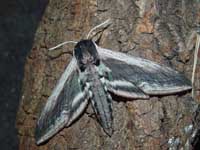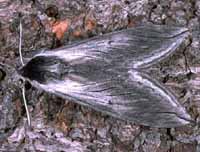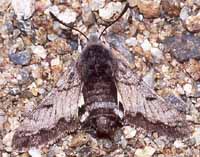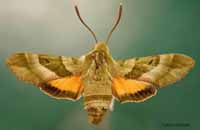Sphinginae subfamily
Sphingini tribe:
 |
This species has not been reported in your county, but may be
there as a very rare stray. The moth is a very
strong flier and is frequently encountered far north of its usual
range.
|
 |
This large bodied moth flies in tobacco fields and vegetable gardens
(potatoes, tomatoes) and wherever host plants are found. |
 |
Manduca sexta
WO, unlikely, the Carolina Sphinx.
Fw upperside has indistinct black, brown, and white markings.
Hw upperside is banded with black and white and has two black zigzag median lines that are very close together
with hardly any white showing between them.
Fw fringes are spotted with white.
|
 |
The upperside of the forewing is pale silver-gray with a series of
black dashes, a white patch at the tip, and a white stripe along the
outer margin. The upperside of the hindwing is black with blurry
white bands.
|
 |
Sphinx chersis
WO, the Northern Ash
Sphinx or Great Ash Sphinx
The upperside of the forewing is soft dark-gray to blue-gray with
a series of black dashes, one reaching the wing tip. Note grey
thorax with narrow black lines.
|
 | Sphinx dollii (Wing span: 1 3/4 - 2 1/2 inches (4.5 - 6.3 cm)),
flies in arid brushlands and desert foothills from Nevada and
southern California east through Utah,
Arizona, Colorado, and New Mexico to Oklahoma and Texas.
|
 |
Forewings, long and slender, are held close to the body when the moth
is at rest.
I only see them occasionally on P.E.I. despite visiting lights
frequently. Hence they may be present, but seldom seen. |
 |
Sphinx perelegans adults fly in montane woodlands and mixed chaparral-type vegetation as a single brood
in the north, with adults mainly on the wing in June and July.
It flies from dusk until after midnight. Note dark thorax. |
 |
Sphinx vashti
USGS, the Snowberry Sphinx
The upperside of the forewing has a narrow black subterminal line
bordered by a white inverted V-shaped line on the outside, and a
black line running inwards from the apex of the wing.
It is most often found in montane woodlands and along streamcourses.
|
Smerinthini Tribe:
 |
This one is quite similar to Pachysphinx modesta, with modesta
being smaller and darker.
Moths should be on the wing from June-August.
|
 |
Smerinthus cerisyi
WO, the Cerisyi's
Sphinx or One-eyed Sphinx, Larvae feed on poplars and willows.
Flight would be from late May-July as a single brood.
|
 |
This small species is probably present in your county. This species ranges across North
America.
The hindwings have a small blue eyespot ringed with black on a yellow
background.
|
Macroglossinae subfamily
Dilophonotini Tribe:
 |
Erinnyis ello USGS, as a stray, the Ello Sphinx:
Abdomen has very distinct gray and black bands. Female's fw upperside is pale gray with a few dark dots near outer margin. Male's fw upperside is
dark gray and brown with a black band running from base to tip. Hindwing upperside is orange with wide black border.
|
 |
Hemaris thetis USGS, the Thetis Clearwing or Bee Hawk Moth,
The moth flies along forest edges and in meadows, gardens and
brushy fields. Day-flying adults nectar at lantana, dwarf bush honeysuckle,
snowberry, orange hawkweed, thistles, lilac, Canada violet, etc.
|
Philampelini Tribe:
 |
Eumorpha achemon
WO, very unlikely,
the Achemon Sphinx
Adults nectar from flowers of Japanese honeysuckle
(Lonicera japonica), petunia (Petunia hybrida),
mock orange (Philadelphus coronarius), and phlox (Phlox).
Fight would be from June to August. Larvae feed on grape foliage. |
Macroglossini Tribe:
 |
Euproserpinus wiesti adults fly, during the day, over sand washes
and prairie
blow-outs as a single brood from May-June.
|
 |
Adults nectar at flowers during the warm parts of the day.
Euproserpinus phaeton adults fly swiftly and close to the ground over
dry washes and flat areas in deserts as a single brood from
February-April.
|
 |
Hyles lineata
USGS,
the White-lined Sphinx
Adults usually fly at dusk, during the night, at dawn, and during the
day. Moths nectar at a number of different flowers and oviposit on
Epilobium cana (California fuchsia) and
Hooker's Evening Primrose. |
 |
Adults fly in the afternoon from April-June in oak woodland and
pine-oak woodland in foothills, nectaring from chia, heartleaf
milkweed, golden currant, bluedicks, fairyfans, vetches,
thistles, hedgenettles, etc. |
|
|
